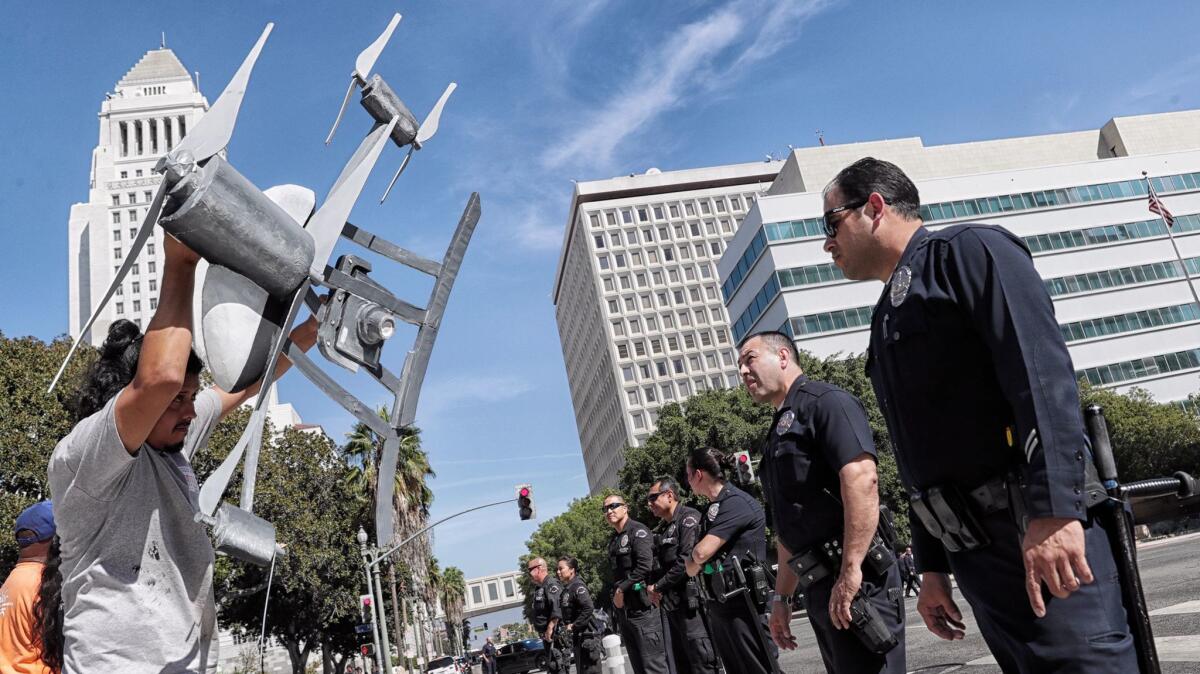LAPD becomes nation’s largest police department to test drones after oversight panel signs off on controversial program

After months of often-heated debate, a civilian oversight panel Tuesday signed off on a yearlong test of drones by the Los Angeles Police Department, which will become the largest police department in the nation to deploy the controversial technology.
The Police Commission’s 3-1 vote prompted jeers, cursing and a small protest that spilled into a downtown intersection just outside the LAPD’s glass headquarters — evidence of the opposition police have faced in recent weeks as they tried to reassure wary residents that the airborne devices would not be misused.
The use of drones — or “small Unmanned Aerial Systems,” in police-speak — has become a contentious issue for law enforcement in Los Angeles, where the nation’s largest sheriff’s department has flown one since January.
Advocates say camera-mounted drones could help protect officers and others by collecting crucial information during high-risk situations or searches without risking their safety. For many privacy advocates and police critics, however, the drones stir Orwellian visions of unwarranted surveillance or fears of militarized, weapon-toting devices patrolling the skies.
LAPD brass, along with police commissioners, tried to ease those concerns by promising careful restrictions on when the drones would be used and strong oversight of the pilot program. Weapons and facial-recognition technology will also be prohibited.
But some critics said they could not trust the department to follow its own rules, no matter how stringent.
“Mission creep is of course the concern,” said Jim Lafferty of the National Lawyers Guild Los Angeles. “The history of this department is of starting off with supposedly good intentions about the new toys that it gets … only to then get too tempted by what they can do with those toys.”
The president of the union representing the LAPD’s rank and file praised the commission’s decision, calling drones “a tool that will protect both police officers and residents.”
“Whether it’s an active shooter at a school, or a suspect barricaded in a home in a Los Angeles neighborhood, this technology will help us save lives,” Craig Lally, the union’s president, said in a statement.
After the vote, LAPD Chief Charlie Beck said the department probably would purchase two drones — one to use and one for backup — and roll them out in about 30 days.
The debate over whether the LAPD should use drones began in 2014, when the department received two Draganflyer X6 drones from police in Seattle — devices the Washington agency unloaded after heavy criticism from the public.
The outcry continued in L.A., and the drones were grounded — and ultimately destroyed — before they were ever flown.
“I will not sacrifice public support for a piece of police equipment,” Beck said at the time.
Commissioner Cynthia McClain-Hill, who cast the sole vote against the drone program Tuesday, asked Beck about his comments three years ago and why he thought now was a good time to revisit the issue. He pointed to the wider use of drones by other agencies and what he described as a “much more robust feedback mechanism” this time around.
Many in the audience jeered.
“I know that all of you think that the process means nothing to me, but that is not true,” Beck told the crowd. “Are we going to agree in the end? Maybe not. But I will have heard you.”
McClain-Hill, though, said she believed the LAPD failed to do “what it should do and needs to do in order to build the trust that is required to support the implementation of this technology.”
For weeks, the LAPD has sought public input on its potential use of drones. The department solicited written feedback and held community meetings, during which officials described situations when the devices would be useful, such as looking inside a building where a suspect was barricaded or quickly searching for victims after an active-shooter incident.
Dozens of people expressed their skepticism during those forums. And police officials said only a fraction of the hundreds of emails the department received had encouraged it to move forward with the initiative.
The opposition intensified this week when the American Civil Liberties Union of Southern California and the Stop LAPD Spying Coalition sent letters to police commissioners urging them to reject the program.
Matt Johnson, the Police Commission’s vice president, said specific changes were made to the rules in response to concerns, including the ban on facial-recognition software.
“It’s not surprising to see the level of passion over this issue,” Johnson told the audience Tuesday. “Whether you are happy with the policy or not, the policy, I do believe, has been made tighter and better because of your input.”
Johnson was joined by two other commissioners — Sandra Figueroa-Villa and President Steve Soboroff — who said they believed the policy offered strict limitations and enough oversight to allow the one-year test to proceed.
Under those rules, only SWAT officers will be allowed to fly drones during a handful of specific, high-risk situations. They can also be used during search and rescue operations, or when looking for armed suspects who have “superior firepower,” an “extraordinary tactical advantage” or who are suspected of shooting at an officer.
Each flight must be approved by a high-ranking officer. Any request to fly a drone — whether approved or not — will be documented and reviewed. The Police Commission will also receive quarterly reports that will be made public.
At the end of the yearlong program, commissioners will review how the drones were used and decide whether to continue.
ALSO
Fire near Mt. Wilson Observatory threatens TV towers
Evacuations ordered as crews battle wildfire in Santa Cruz mountains
Female lawmakers, staffers and lobbyists speak out on ‘pervasive’ harassment in California’s Capitol
UPDATES:
9:05 p.m.: This article was updated with comments from police commissioners, LAPD chief Charlie Beck, drone opponents and a union representative.
1 p.m. This article was updated with the Police Commission’s vote and scenes from the protest that followed.
10:05 a.m. This article was updated with details from a news conference outside LAPD headquarters Tuesday morning.
This story was originally published at 5 a.m.
More to Read
Sign up for Essential California
The most important California stories and recommendations in your inbox every morning.
You may occasionally receive promotional content from the Los Angeles Times.











